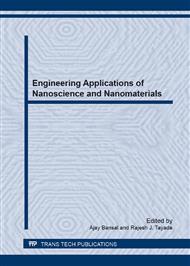p.151
p.165
p.175
p.197
p.217
p.243
p.257
p.271
p.285
Biopolymer Stabilized Iron Sulphide Nanoparticles for Removal of Acid Black 1 Dye
Abstract:
India is one of the largest producer and exporter of dyestuff among developing countries. Large amount of dyes is lost in industrial effluents during production and industrial use. Persistence of dyes in the environment, their non-biodegradability and toxicity necessitate urgent steps to develop environment-friendly approaches to remove them from wastewaters. The present work describes attempts to use iron-based catalytic nanoparticles (NPs) for removal and degradation of Acid Black 1, one of the notoriously toxic dyes. A rapid screening assay was developed in order to select NPs possessing reducing properties. Methylene blue (MB) dye (0.1mg/L, 250µl) was exposed to different preparations of NPs (7mg) for 30 minute in a 96-well microtiter plate and read at 630 nm using an ELISA reader. Iron sulphide nanoparticles (FeSNPs) stabilized by a plant biopolymer (BP) could remove >95% MB and were selected for further studies. The FeSNPs could remove Acid Black 1 efficiently (73.8%) with specific dye removal capacity of 19.7 mg/g NPs. FeSNPs were immobilized in alginate beads (average diameter 3.45 mm) and packed in polypropylene columns (22.5 cm long, 3 cm i.d.) having bed volume of 42 ml. Acid black 1 solution (20 mg/L) was passed through the columns at predetermined flow rates in up-flow mode using peristaltic pump. The mass transfer kinetics were favourable at a flow rate of 2.2 ml/min (mass transfer coefficient 9.38X10-5 L.mg-1.min-1), and 120 bed volumes of the solution could be treated with efficiency exceeding 90%. Analysis of column effluent by UV-visible and FTIR spectroscopy revealed that removal of dye from solution was due to reductive degradation.
Info:
Periodical:
Pages:
285-293
Citation:
Online since:
May 2013
Authors:
Keywords:
Price:
Сopyright:
© 2013 Trans Tech Publications Ltd. All Rights Reserved
Share:
Citation:


